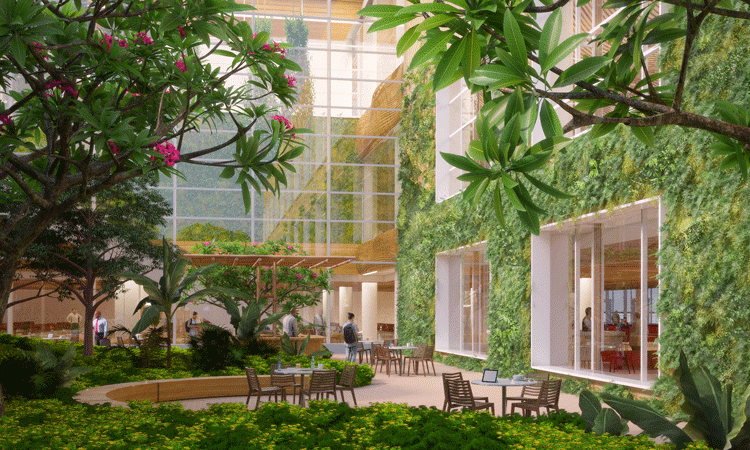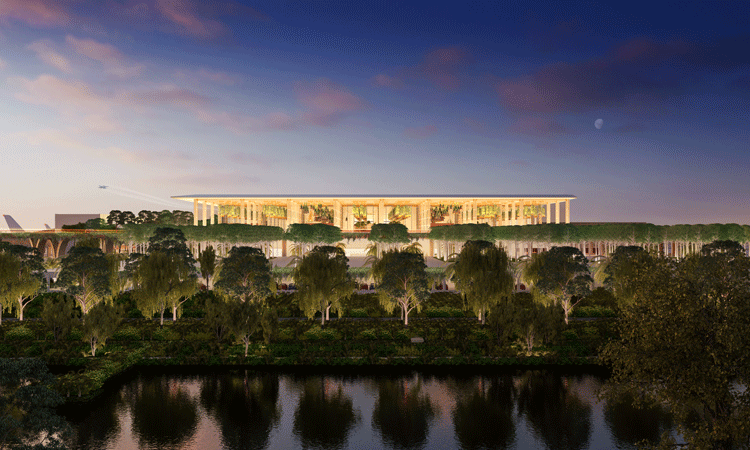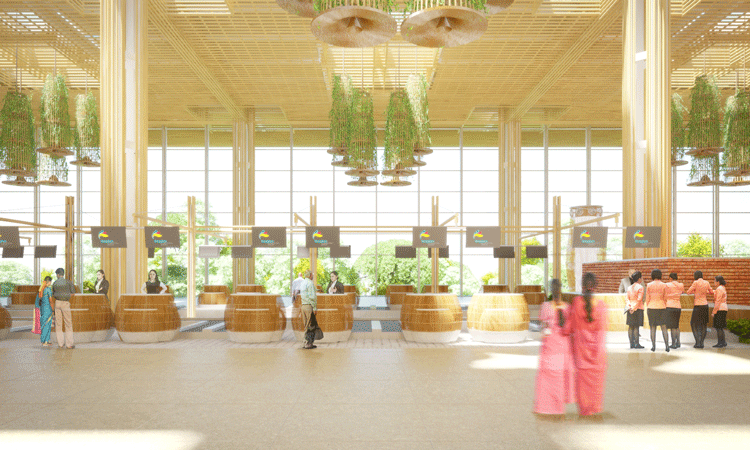Exploring Bengaluru’s sustainable garden terminal
- Like
- Digg
- Del
- Tumblr
- VKontakte
- Buffer
- Love This
- Odnoklassniki
- Meneame
- Blogger
- Amazon
- Yahoo Mail
- Gmail
- AOL
- Newsvine
- HackerNews
- Evernote
- MySpace
- Mail.ru
- Viadeo
- Line
- Comments
- Yummly
- SMS
- Viber
- Telegram
- Subscribe
- Skype
- Facebook Messenger
- Kakao
- LiveJournal
- Yammer
- Edgar
- Fintel
- Mix
- Instapaper
- Copy Link
Posted: 26 November 2019 | Hari Marar - BIAL | 2 comments
Bengaluru International Airport is a pioneer among airports in Asia with regard to sustainability. Hari Marar, MD and CEO of Bangalore International Airport Limited, tells us about the various environmentally-friendly initiatives that have been implemented.


Not only is the Kempegowda International Airport Bengaluru (KIAB) one of the fastest growing airports in the world with an annual footfall of over 33 million passengers, it has built a solid reputation for sustainability initiatives. At Bangalore International Airport Limited (BIAL) we strive to not only transform the airport into a model airport but establish innovative methods for ecological sustainability.
To cater to the stupendous growth in passenger volumes projected over the next few years, Bangalore International Airport (BLR) – as KIAB is popularly known – is investing approximately US$2.5 billion into infrastructure expansions that include constructing Terminal 2, a new runway and associated projects, with a firm focus on sustainability in design, construction and operation.
The Terminal 2 expansion has all the credentials to be among the best in the world. It is built on four guiding principles: Technology leadership, being a terminal within a garden, environmental and ecological stewardship, and a celebration of Karnataka’s rich heritage and culture.
Constructing an airport terminal in a garden
The ‘Terminal in a Garden’ – designed to revive Bengaluru’s green identity – has been meticulously planned to create state-of-the-art infrastructure with a low carbon footprint. From construction to operational efficiency, every aspect of T2 is focused around green principles.
T2 is designed to provide an innovative airport experience, including calming gardens at areas of high stress, exciting gardens along the journey and restful gardens at waiting areas. With lush greenery, both within and outside, T2 will be a visual delight. The concept aims to give passengers a natural feel of a garden as they pass through every terminal touchpoint. The outdoor garden will enhance the aesthetics, while offering the feel of a natural forest that includes water bodies and natural topography. The gardens will feature distinctive plants, including native specimens of trees, flowering trees and shrubs. The installation of portals, water bodies, rocks, digital technology, lighting and signature plants at strategic locations will further enhance the overall experience.
There will be minimum reliance on artificial illumination, treated water used for the landscape indoor gardens, and a leveraged temperate climate to reduce dependence on mechanical conditioning. Special attention will be placed on the use of construction material to minimise environmental impact and maximise sustainability. Policies are in place to recycle all waste material from the production process and ensure more energy-efficient processes are followed. Products will be chosen from certified sustainable sources with recognised accreditation while ozone-depleting substances and components requiring high-energy input will be prohibited.
To further demonstrate its commitment to establish innovative methods for sustainable growth, BIAL has already implemented various landmark initiatives with a major focus on energy saving, water conservation, waste management and pollution control measures with an aim to take sustainability to new heights.


Water management at Bengaluru
Our airport is located in an area where the water table, over the years, has depleted substantially. With over approximately 100,000 passengers arriving and departing each day, the airport requires millions of litres of water. To ensure that the water supply remains uninterrupted, BIAL has put in place measures that has not only made BLR Airport water neutral but improved the region’s water table.
Rainwater harvesting
The rainwater discharge from the airport buildings is stored in large underground tanks with a 1.7 million-litre capacity, treated and reused. Excess water from the tanks is then allowed to flow into stormwater drains and recharge the aquifer as well as flow into adjacent lakes. Going forward, all stormwater and water discharge, including grey and black water, will be treated onsite. The revival of lakes in the airport’s vicinity is a huge benefit for the local communities who depend on these water bodies for agriculture.
The ongoing development of rainwater harvesting ponds – nearly 70 acres within the BLR Airport campus – will create large water bodies that will support BIAL’s sustainability initiatives through harvesting over 750 million litres of rainwater per annum. This will translate to 1.6 million litres of usable water every day through the year.
We have engaged the prestigious Indian Institute of Science (IISc) to study the current scenario and suggest sustainable methods for restoration of water bodies. To further improve water resources, BIAL is in the process of revamping the existing lakes and developing new sources.
Groundwater recharge pits
With 315 recharge pits located in the stormwater drains, BIAL has adopted the development of unlined drains on the campus to increase recharge. A large volume of rainwater is used to recharge the aquifer. The well-designed stormwater drain flows into the adjacent lake. Approximately 500 million litres of rainwater has been used to recharge the ground and lake, thus increasing the water table in the local area.
Rehabilitation of old wells
Six abandoned wells have been rehabilitated, cleaned and repaired. Due to the recharge system that is newly in place, the wells now hold substantial amounts of water, even during the summer months.
Energy management at Bengaluru
Our vision is to make BLR Airport 100 per cent powered by renewable energy by 2020. This initiative will result in a significant reduction of carbon emissions. To achieve this, we are generating its own power through solar energy and installing LEDs to reduce the dependence on non-renewable energy.
Solar energy
Our airport has increased consumption of solar power to over 50 million units through on-site and off-site solar power purchase agreements (PPA) that meet 67 per cent of its annual energy requirements. That apart, the airport is making optimal use of natural light with minimum reliance on artificial illumination. BIAL’s other energy-efficient initiatives include installation of solar street lighting; solar-powered security cabins; and a solar water-heating system for the cafeterias.
Installation of LEDs
The street lights, perimeter lighting and airfield lights have been converted into LED lighting. This will further reduce the airport’s dependence on non-renewable energy. The existing 400 high-pressure sodium vapour lamps (HPSV) airside have been converted into energy-efficient LEDs to provide enhanced safety for pilots, greater visibility for ground staff and reduced energy consumption. The new installation deployed airside will help BLR Airport save 11.5 lakh units of electricity annually, reducing dependence on non-renewable energy sources. This will also result in an overall reduction in carbon emissions. Meanwhile, BIAL is working to convert the existing terminal and all landside lights into LEDs.
Environment management at Bengaluru
Our pro-environment strategy allows for the operation and development of the BLR Airport in a manner that effectively controls and contains environmental impact and complies with environmental requirements.
No plastic
With an aim to achieve increased recyclables and zero landfill by 2021, BIAL has eliminated single-use plastic from the campus. All lounges, food and beverage outlets and the Day Hotel have put in place stringent measures to reduce dependency on plastic. As a first step, straws, coffee stirrers, plastic cutlery and polythene bags are banned at the BLR Airport, and plans are afoot to further reduce the plastic dependence.
Pollution control
Several anti-pollution drives have been conducted to keep the environment clean and safe. This includes a focus on landscaping, afforestation drives, installation of an airside oil-water separator and hazardous waste centre to prevent contamination. As an influencer, BIAL has provisioned e-charging stations, emission-control mechanisms and driver-awareness campaigns to achieve meaningful community-coordinated initiatives.


Waste management at Bengaluru
Our aim is to use the generated waste as a source of energy. Under its waste management policy, BIAL has implemented two initiatives: A sewage treatment plant (STP) and a solid waste management (SWM).
Sewage treatment plant
In order to recycle its own waste water and reduce dependency on fresh water, BIAL has devised an environmental planning strategy to design and construct an STP. The wastewater generated from the terminal and other buildings are treated at the two-million-litre capacity STP, using the extended aeration system. This treated water is then reused for KIAB’s extensive gardens as well as for the air-conditioning systems. As part of its Phase 2 development, BIAL is constructing an additional STP, capable of processing three MLD/day. This facility will support Terminal 2 in flushing and air-conditioning.
Solid waste management
Our airport generates over 20 tonnes of waste each day. In order to reduce the carbon footprint from this waste disposal, BIAL is developing its own SWM facility. The first phase – which is expected to go live by the end of 2019 – will have the capability to process 20 tonnes per day (TPD). This can be enhanced to 60 TPD, based on need.
Once commissioned, organic waste will be converted into bioenergy to generate enough electricity to power approximately 5,000 households every year. The facility will also generate 1.5 million kilograms of organic compost annually. This will ensure zero-landfill disposal from the BLR Airport, while energy generated will be used by BIAL.
Ecological management at Bengaluru
Our airport has its own wildlife department, with qualified professionals working round the clock to manage bird and animal activity in the operational areas of the airport.
We have adopted a sustainable approach to wildlife management, which is unique among airports, divided into two categories – active management and passive management.
Landscaping and greenbelt development are one of the most important aspects to reduce air, water and dust pollution; BIAL has continually focused on landscaping since the inception of the airport 11 years ago.
Our full-fledged Landscape Department, consisting of well-qualified horticulturists and irrigation experts, play a vital role in aesthetic improvement through planting trees and shrubs along the roads, parking areas and office buildings. Together, they control soil erosion, improve aesthetics of the area and the surrounding micro-climate.
Bengaluru: The Garden City of India
With just 40 acres of landscape garden in 2008, we have gradually increased the green space at BLR Airport to over 100 acres.
Automated irrigation systems have been installed to provide uniform water distribution to maintain its vast greenery, covering an area of over 122,500 square metres. The team has its own fully-fledged plant nursery to ensure a continuous supply of plants.
Greenery facilitates the survival of local flora and fauna, as well as a healthy working environment for employees, stakeholders, customers and airport users. As Bengaluru is known as the Garden City of India, we have tried to reflect this image at the airport by creating world-class gardens and green spaces, and will continue to do so in the future.
Biography
Hari Marar is Managing Director and CEO at Bangalore International Airport Limited (BIAL). He was part of the core leadership team that successfully licensed and operationalised a Greenfield Airport project at Bangalore. In this role, he defined the operational concept of the greenfield airport and introduced and implemented several modern, state-of-the-art airport management systems, for the first time in India. Prior to joining BIAL, Marar spent 13 years with service industries including hospitality and airlines.
Issue
Related topics
Airport development, Emissions, Sustainability, Sustainable development, Terminal operations



















Excellent air port with all basic amenities for a common man including transport & estaurants
I passed through the airport about two months ago. Wonderful airport in a nice environment. Hari should be complimented for the measures that he took to conserve water and provide a sustainable green environment with a low carbon footprint. My wife and I had lunch with my grand-niece, who is a partner in an architectural firm in Bangalore (Ostraca) showed some of the good features of the airport.